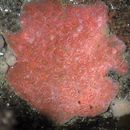Comprehensive Description
provided by Invertebrates of the Salish Sea
Biology/Natural History: In California, colonies of this species can grow to 7 cm diameter in 3 months. The larvae are brooded in the atrial cavity in spring and summer. The symbiotic copepod Arthurhumesia canadensis may be present inside the zooids. The amphipod Polycheria osborni is also a rare symbiont. The nudibranch Hermissenda crassicornis often feeds on the zooids.
- license
- cc-by-nc-sa
- copyright
- Rosario Beach Marine Laboratory
Habitat
provided by Invertebrates of the Salish Sea
Rocks and pilings in areas with current.
- license
- cc-by-nc-sa
- copyright
- Rosario Beach Marine Laboratory
Distribution
provided by Invertebrates of the Salish Sea
Geographical Range: Southern British Columbia to San Diego, CA
- license
- cc-by-nc-sa
- copyright
- Rosario Beach Marine Laboratory
Habitat
provided by Invertebrates of the Salish Sea
Depth Range: Intertidal to 40 m
- license
- cc-by-nc-sa
- copyright
- Rosario Beach Marine Laboratory
Comprehensive Description
provided by Invertebrates of the Salish Sea
This compound, colonial tunicate has many individuals all enclosed within the same gelatinous tunic. The colony grows as a thick, gelatinous or fleshy, encrusting, often lumpy sheet or slab which is at least 5 mm thick but does not have a stalk. The zooids are arranged in systems--individual zooids have their oral apertures separately at the surface, but the atrial apertures of multiple zooids all open together into the same cavity with a single, larger opening. The overall colony color is red, pinkish, or pale and may be encrusted with sand. The separate oral siphons of the zooids are usually red or orange-brown. The pharynx of zooids has 12-16 rows of stigmata. Colonies may be up to 5 cm thick. Colony diameter to 20 cm.
- license
- cc-by-nc-sa
- copyright
- Rosario Beach Marine Laboratory
Look Alikes
provided by Invertebrates of the Salish Sea
How to Distinguish from Similar Species: Aplidium californicum also forms a gelatinous or fleshy colony with zooids in systems but the zooids are tan, yellowish, or orange-brown and usually have less stigmata on the pharynx. Archidistoma molle can be reddish or pink but the zooids are not in systems and the colony tends to be globular in form.
- license
- cc-by-nc-sa
- copyright
- Rosario Beach Marine Laboratory

